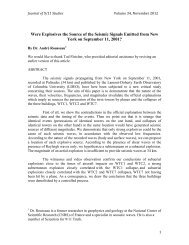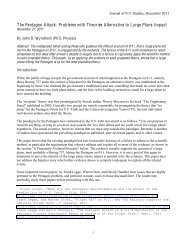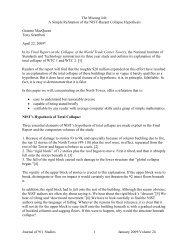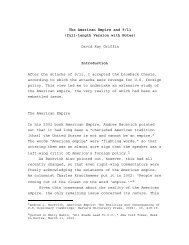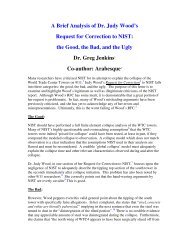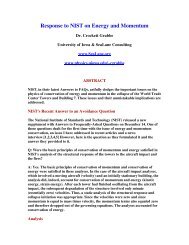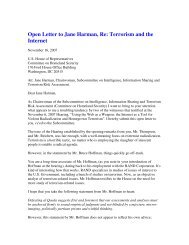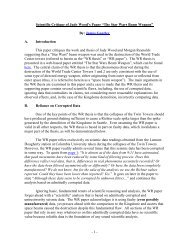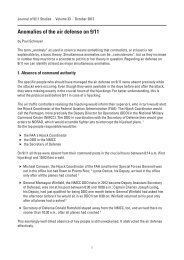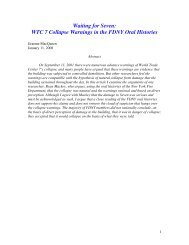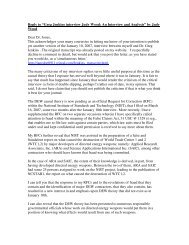interview with dr. judy wood and dr. greg jenkins - Journal of 9/11 ...
interview with dr. judy wood and dr. greg jenkins - Journal of 9/11 ...
interview with dr. judy wood and dr. greg jenkins - Journal of 9/11 ...
You also want an ePaper? Increase the reach of your titles
YUMPU automatically turns print PDFs into web optimized ePapers that Google loves.
There is no evidence that any significant amount <strong>of</strong> dust “went into the upper<br />
atmosphere” during the collapse <strong>of</strong> the WTC towers as Wood claims, <strong>and</strong> she makes use<br />
<strong>of</strong> misleading interpretations <strong>of</strong> photos to support this theory <strong>and</strong> also misrepresents<br />
<strong>of</strong>ficial USGS studies. 31<br />
GJ: You can take any kind <strong>of</strong> distribution you want. The rough radius roughly makes an<br />
area six times bigger, if you look at the debris coming down <strong>of</strong>f <strong>of</strong> that building.<br />
Comment: A scientist can speak <strong>of</strong> ‘distributions’ <strong>and</strong> know what another scientist is<br />
saying. In this case, a distribution is the precise form that the debris may be dispersed.<br />
For instance, a Gaussian distribution <strong>of</strong> debris would be a bell curve centered upon a<br />
tower, <strong>and</strong> the radius may be defined as either 1 or 2 st<strong>and</strong>ard deviations. Another<br />
example could be an exponential distribution where the amount <strong>of</strong> debris tails <strong>of</strong>f<br />
exponentially from the center <strong>of</strong> the tower, <strong>and</strong> the radius defined as the 1/e point. No<br />
matter what the distribution, one can always define a radius <strong>with</strong>in which the majority <strong>of</strong><br />
the debris from the towers is located.<br />
JW: But what are you calling debris? Are you calling this Nano-particles?<br />
GJ: Nano-particles?<br />
Comment: Again, ‘nano-particles’ is a nonsensical term in reference to the debris<br />
generated from the towers. Particle sizes on the scale <strong>of</strong> a nanometer (10 -9 meters) are<br />
normally called ‘elements’ <strong>and</strong> ‘molecules’.<br />
JW: The very fine, ultra-fine dust that was in the upper atmosphere for months.<br />
Misleading Argument #9:<br />
Official studies indicate that “the particles in greatest abundance (mass) in the dust<br />
were the unregulated supercoarse—not the ultra-fine.” 32<br />
GJ: The dust was an average <strong>of</strong> 70 microns large.<br />
Comment: At the time, Dr. Jenkins was judging the average size <strong>of</strong> particles based upon<br />
dust samples from Lioy et al. 33 Debris captured during the collapse collected from Janette<br />
MacKinlay’s apartment (<strong>11</strong>3 Liberty Street just across from the South Tower) shows that<br />
75% <strong>of</strong> the debris was larger than 1.3mm by weight thus suggesting that the average<br />
size particles are much larger than 70 microns.<br />
JW: Which dust?



